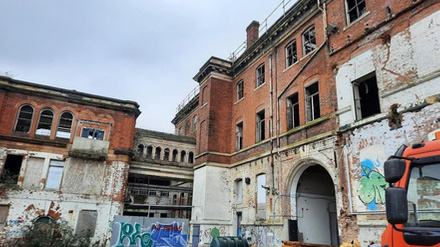Protecting Built Heritage Inquiry
Call for Evidence - Written evidence submitted by The Council for British Archaeology (CBA)
Who we are
The Council for British Archaeology (CBA) is a charity committed to making archaeology accessible to anyone interested in exploring the stories of people and place. As the voice of archaeology in the UK we bring together community groups, commercial units, academics and heritage organisations to create and share opportunities to participate, discover and be inspired by archaeology.
As a national amenity society, the CBA are statutory notifyees within the planning system. We review over 4000 planning applications each year, 85% of which are for Listed Building Consent (LBC). Through our Listed Buildings Casework team and advocacy work we speak up for the historic environment. Our primary focus is around the archaeological and historic interest in the built environment and its appropriate conservation and reuse. Archaeological interest and evidential value lie both above and below ground, across our landscapes and settlement patterns. We believe that changes within the historic environment should be informed by an understanding of where significance lies in evidencing how places have evolved in relation to people over time. We champion the important contribution that the historic environment makes to the place-based identity and wellbeing of current and future generations. Adapting and reusing the historic environment and archaeological interest lies at the heart of our mission and values.
What is a Heritage Asset?
The CBA take a broad definition of heritage assets as those sites that relate to the heritage of a place. This is not restricted to buildings which are designated. ‘Non-designated Heritage Assets’ (NDHAs) can be central to the historic identity of places. The same principles apply to managing all built heritage. Understanding which aspects contribute to a place’s significance should inform managing change to it.
Response to specific questions
- What are the most significant challenges facing owners and operators of built heritage assets, and how are they affecting what those sites can offer?
There are many challenges. The most significant are around skills shortages for maintenance and repair works, poor advice, Local Planning Authority (LPA) capacity and the elevated cost of appropriate works.
- Maintenance and Repair – Old buildings need routine care and maintenance. Increased risks of flooding, storm damage, over heating etc triggered by climate change create
anadditional maintenance requirements and a need to adapt old buildings to mitigate impacts. The rise in energy bills coupled with contemporary expectations of thermal comfort increase the need to insulate buildings. The growing costs of looking after old buildings; energy bills, insurance premiums, maintenance, repair and adaptation are very challenging for their owners and operators. - Skills shortages – There are not enough construction workers in the country. Within this well-recognised issue, there are not enough construction workers with the ‘specialist’ skill set needed for maintenance and repair of old buildings. Building contractors are trained to work with contemporary construction techniques and materials. Amongst the construction profession there is a widespread lack of understanding around how old buildings (approx. pre-1919) operate differently to modern construction. It is extremely difficult for owners and operators to find building contractors who can specify and carry out the appropriate works for old buildings. This is not limited to heritage assets, it applies to all pre-1919 structures. The use of inappropriate techniques and materials can cause long-term deterioration and create additional problems, requiring further remedial work at a later date.
- Poor Advice –The plethora of information for e.g. damp proofing and insulation (amongst other maintenance and retrofit tasks) promoted online by manufacturers and by building contractors creates a barrage of misleading information and poor advice to owners and operators of old buildings. [1] Historic England have drafted guidance around the differences between old and new construction and what this means in terms of maintenance and adaptation. The extent of contrary advice and contractors who are not familiar with the different techniques and materials required in old buildings makes maladaptation prevalent. The most common consequence is chronic damp, trapped in the fabric of a building by the introduction of cementitious and non-breathable materials.
- Shortage of specialist officers at Local Planning Authorities (LPAs) – Through the CBA’s role as a National Amenity Society we have seen the impact of cuts to Conservation Officer posts at LPAs and the impact this can have on decision making in both advice input and response time. For owners and operators this results in frustrating delays. For Conservation Officers this leads to a demoralising workload, driving many into the private sector.
- The relative cost of works – The scarcity of skilled building contractors with conservation knowledge and experience makes them both hard to find and disproportionately expensive. This escalates the cost of carrying out even maintenance and repair works to buildings, as well as the timetable for their delivery.
What interventions are needed to prevent the managed decline of heritage assets on publicly-owned land?
- The managed decline of heritage assets is effectively incentivised through the current VAT relief on developing cleared sites and new build. This makes the cost of repairing standing buildings 20% more expensive for developers than demolishing them and redeveloping the site. This position fundamentally undermines the government’s emphasis on sustainable development (NPPF chapter 2). As a country we must recognise the embodied carbon in standing buildings as part of the carbon impact of demolishing old buildings to redevelop sites. Particularly in relation to non-designated heritage assets it is in developers’ interests to allow buildings to deteriorate to a point where their retention becomes unviable. This creates derelict sites, harming local character. The NPPF identifies economic, social and environmental sustainability in paragraph 8. Too often the sole focus is on economic sustainability. Demolishing such sites, as opposed to adapting them for a new use impacts local identities and sense of place, especially when these buildings are old industrial mass employment sites. We need reform of the VAT system to stop wasting buildings and their embodied carbon. For a more detailed outline of the issue and recommendations for effective fiscal reform visit the Don’t Waste Buildings website.
- It is essential to support the training of building contractors in the skills needed to maintain and repair pre-1918 buildings. 5.9 million buildings, which is 21% of our building stock, was built before 1919.[2] We need to develop a skilled workforce to maintain these buildings. This can be done through apprenticeship schemes for those entering construction professions. It is also essential to upskill existing builders on the difference between how old and new buildings operate in terms of airflow and breathability. Both the theory of how old buildings operate and practical skills in using materials like lime should be made widely available as Continued Professional Development (CPD).
- Publicly owned heritage assets should be managed with continuity by devising Conservation Management Plans (CMPs), specific to a site. A good CMP creates an overview of the building, identifying the site’s special interest (or significance) and how it should be managed to conserve that cultural significance. As a shared, living document they form the basis for any works to a site, articulating everything from a schedule for routine maintenance and repair and an archive of previous changes to opportunities for development and design parameters for adaptive change.
What can the Government do to make it easier for communities or local businesses to take ownership of historic buildings?
Community Asset Transfer, transferring the ownership of a historic building from a public sector body to a community group is a huge undertaking for those taking on the responsibility for the site, especially if it requires building works and/or a new adaptive use. Peer to peer support and mentorship from those with similar experiences are invaluable. The Heritage Trust Network do this. With more resources they could do so much more!
A scheme that supports the creation of Conservation Management Plans (CMPs) for those considering taking on a historic building could be facilitated through the government’s arms-length heritage bodies; Historic England and Cadw. Both are well placed to administer schemes that support communities / local businesses who take on the ownership / management of a heritage asset. Support could take a variety of forms: Creating scaffolded templates for CMPs which identifying all the necessary considerations for long term management of a site, small grants for engaging heritage professionals to complete a CMP at more complex sites, workshops / networking forums for community groups taking on heritage assets.
Listed Building Consent Orders (LBCOs) are intended to reduce the need for Listed Building Consent applications (and the bureaucratic process it entails) for specific works to specified types of listed buildings in an area. This reduces the burden on Local Authority Conservation staff and enables owners / managers of buildings to undertake works according to pre-determined parameters, saving time and money. Devising the Listed Building Consent Order requires work ‘up front’. Ring fenced funding for Local Planning authorities to achieve this would be cost effective in the long term.
- How effective are the current funding and finance models for built heritage?
The current finance models are through either private or grant funding. The government could do more to fiscally incentivise appropriate care of built heritage. We would reiterate our comments regarding the VAT relief on new build development.
What should long-term public funding for the sector look like?
- As a minimum, a commitment to maintaining the current levels of funding to the government’s arm’s-length heritage bodies; Historic England and Cadw who support the widespread delivery of heritage funding to smaller organisations is essential. This funding provides as essential catalyst to the wider care and reuse of the historic environment
- Creating more certainty within the Heritage Sector’s complex funding model[3] would benefit the whole sector. The annual funding settlements Historic England and Cadw receive cascade to support an ecosystem of smaller organisations and localised projects. The uncertainty of their funding settlements each year passes uncertainty on throughout the whole ecosystem. Annual funding agreements make hundreds of small organisations vulnerable to collapsing and their long-term planning impossible.
The Heritage Sector is lean and efficient, often harnessing the efforts of volunteers and punching above its weight in terms of delivery on financial investment. Small amounts of money can make a big difference to local groups.
The breadth and complexity of heritage means it straddles multiple government departments and policy areas; DCMS, DEFRA, MHCLG, as well as contributing to transport and education portfolios. The financial climate of austerity and departmental budget cuts compound heritage being sidelined as a peripheral concern within each individual department. A solution would be to make Historic England and Cadw National Portfolio Organisations, akin to the Arts Council, with directly funded budgets to distribute throughout the Heritage Sector. Establishing consistent and stable resource would prevent the inherently unstable nature of short-term funding cycles, which impact hundreds of organisations’ ability for long term planning and capacity building nationwide.
- Long term funding needs to be channelled into apprenticeships and training schemes for Building Conservation skills in the construction sector, teaching the difference between the construction and repair of old and new buildings.
- Nationally, public education is needed regarding the maintenance and repair of old buildings to support all those in pre 1919 houses to minimise their energy consumption effectively. Historic England have drawn up guidance which needs to be made accessible and usable for owners and occupiers of buildings.
- Grant schemes for capital works to public buildings, especially for energy efficiency measures would target environmental sustainability objectives as well as care for heritage for future generations. Conditions for such grants should include appropriate surveys by CARE accredited engineers. Grants could also be measured against the delivery of public benefits from a site.
- There needs to be a change in the financial climate that informs new development. VAT equalisation for repair, maintenance and retrofit with new build development would incentivise developers to reduce the wastage of embodied carbon in standing buildings and adaptively reuse buildings that contribute to a local sense of place. In some instances, subject to conditions, VAT exemption / reduction on repairs to historic buildings could be used to support groups taking on responsibility for heritage assets.
Fundamentally though, it is local authority conservation staff who are best placed to advise on managed change to the historic environment in localities. These specialist services need sufficient capacity to respond to applications as they arise as well as feed into strategic vision led master planning in areas.
- What role does built heritage play in the regeneration of local areas and in contributing to economic growth and community identity?
Built heritage is a proven central tenon to successful urban regeneration projects across the country. Adapting derelict, redundant and under-used structures for a new sustainable use reimagines an existing identity of a place in a powerful act of resilience, restoring pride to communities.
The link between people and places- As mass employment sites, buildings like mills, warehouses and factory complexes were central to the historic identity and development of places. Their derelict condition casts a long shadow of redundancy over an area. Reusing such sites, often primarily as housing, not only revitalises structures, it also supports a real sense of resilience around place-based identity as part of regeneration strategies.
Heritage led regeneration in ex-industrial areas - The following projects exemplify how community projects as part of heritage led regeneration schemes have engaged communities in multiple ways with both with the historical importance of a place and a new forward-looking relevance around sustainability, retrofitting, technology transfer and co-production.
The Ouseburn Trust grew out of a regeneration partnership between Newcastle City Council, the local business community and a team of volunteers that has transformed an ex industrial area of Newcastle into a vibrant and dynamic hub for creative industries, as well as developing a residential community. Established in 1996, there are volumes of exemplars and lessons about what heritage led regeneration can achieve from multiple projects in the Ouseburn.
The Jewellery Quarter Townscape Heritage (JQTH) project had a dual focus on restoring historic buildings and engaging local communities. The four-year project has created an impressive lasting legacy of transformation, re-establishing the unique heritage and character of this area of Birmingham.
Heritage led regeneration in town centres - Many Town Centres and High Streets are blighted by the deterioration of vacant commercial premises exacerbating a rundown character, generating a lack of appeal that further accelerates their decline.
The success of heritage led regeneration schemes in restoring pride of place and triggering economic growth in localities is evidenced in Heritage Action Zones and High Street Heritage Action Zones across the country.
The majority of High Streets contain a lot of old buildings. Empty and under-used they soon deteriorate. A trigger to restoring their active use, resultant maintenance and an improved streetscape character is a primary focus on the upstairs spaces. These often vacant spaces can deliver much needed housing in central locations, well served by public transport and other amenities. Focusing on means to achieve separate access from ground floor commercial premises can provide quality homes, create a substantial additional income stream for owners and boost the local retail economy by recreating a community of residents upstairs.
How can heritage buildings be supported to increase energy efficiency and contribute to the Government’s net zero targets?
- We need national planning policy to explicitly recognise the central role of old buildings in providing new housing whilst minimising carbon usage. Not wasting their embodied carbon contributes towards net zero targets, whilst revitalising places in line with their existing identities is key to restoring pride of place in left behind communities. Establishing this in planning policy will not only contribute to the environmental and social sustainability imperatives of the NPPF (paragraph 8), it will unleash the historic environment’s potential to deliver against the government’s growth agenda.
- The CBA believe there are three key measures government should take to realise this role of old buildings in meeting net zero targets:
- The VAT incentive for developers to entirely clear sites for development must be removed.
- ‘Brownfield buildings’ suitable for adaptive reuse need to be identified as part of the government’s Brownfield Passport initiative.
- Viability Assessments for demolishing or adapting standing buildings need to evaluate the environmental as well as economic viability of both alternative scenarios, including whole life carbon assessments which analyse the carbon cost of the demolition and construction works as well as the operational costs of a building.
- We need to stop under valuing the contribution that adaptive reuse of old buildings makes towards net zero targets. Embodied carbon, the carbon used in the production of materials and used in the construction process support the truism – ‘the greenest building is one that is already standing’. Extending the usable life of standing buildings reduces unnecessary energy consumption as well as continuing the timeless process of adaptive change that characterises our built environment. Adaptation and reuse of valued commodities and resources evidences the shifts in tastes, social attitudes and advances in technologies of previous people throughout history. Future generations will rightly judge us for the gross consumption and wastage of resources used in buildings with a lifespan of less than 100 years. In the face of a climate driven crisis, we need to reappraise the idea of old buildings as inefficient in energy consumption, retrofit them for reduced consumption and look hard at the construction centre in terms of a circular economy.
- The CBA have been campaigning for an improved retrofit led scheme for the St Margaret’s Works (Corah Factory) in Leicester. This redundant site and current planning application, for near total demolition, exemplifies how existing policy fails to deliver genuine regeneration when the social and environmental strands of sustainable development are overlooked. The Corah Factory articulates Leicester’s industrial strength in clothes manufacturing. Regenerating this huge site for housing that retains and reinvigorates the city’s historical industrial strength would also support the community’s identity.
- In practical terms, Historic England, Cadw and Historic Scotland have jointly produced guidance on appropriate retrofit measures to increase the energy efficiency of old buildings, thereby supporting their contribution to net zero targets – Course Handbook: Level 3 Award in Energy Efficiency Measures for Older and Traditional Buildings We need all parts of the construction and development sector to pick up and run with this guidance.
- We also need increased research and investment in retrofit strategies for historic buildings that do not inhabit the way historic building fabric behaves. Westminster City Council have a Retrofit Taskforce, doing valuable work. This could be regarded as a pilot scheme, and its findings rolled out more widely.
- What are the financial, regulatory and practical barriers to preserving built heritage?
Financial
- The VAT relief for new development on entirely cleared sites creates a financial incentive for developers to demolish structures with viable adaptive reuses. This position undermines fundamental principles of sustainable development.
- Creating parity, as a minimum, for retrofit development through the VAT regime would remove the financial barrier to such schemes. Financially incentivising retrofit schemes would better deliver for built heritage, local sense of place and net zero targets.
- Extending VAT parity to maintenance and repair of buildings more widely would further safeguard built heritage.
Regulatory
- Energy Performance Certificates (EPCs) grossly miscalculate the daily energy usage of old buildings, exacerbating an impression of energy inefficiency. EPCs are based on 20th century construction models, making them regularly not fit for purpose by inaccurately calculating the energy usage in older buildings. EPCs need reform to reflect way pre 1919 construction operates.
- EPC ratings and requirements on landlords regarding EPC ratings result in maladaptive insulation measures to old buildings, often resulting in chronic damp issues, decay and health issues for occupants.
Practical
- As noted in response to Q.1., the shortage of construction workers and other trades people familiar with how pre 1919 buildings operate, and the breathable / hygroscopic materials that are essential to these operations, makes finding suitable contractors extremely difficult and expensive.
- Decision times for planning applications is a source of frustration for many owners / operators of historic buildings. From our National Amenity Society role, the CBA know a lack of capacity in local planning authorities, especially amongst specialist staff including Conservation Officers, results in delays. From reviewing thousands of LBC applications, we know that a failure to meet the criteria set out in NPPF chapter 16 means a huge number require revisions, with obvious implications for costs to applicants, time for planners and delays to outcomes.
What policy changes are needed to make restoring historic buildings easier and less expensive?
- Reform the VAT relief that incentivises the total clearance of development sites and disincentivises the retrofit of standing buildings.
- At present the combination of NPPF paragraphs’ 207 and 208 place the duty on local planning authorities to identify heritage impact. This should be done earlier in the process and used to inform the development of proposals. Rephrasing the requirements set out in NPPF chapter 16 should place the onus on applicants to understand significance and assess heritage impact from proposals.
- Guidance that supports improved proposals would save the need for revisions to applications before schemes meet local and national policy requirements. The CBA are statutory notifyees for Listed Building Consent applications in England and Wales. The calibre of Welsh applications, where the onus IS on applicants to assess heritage impact and to follow this guidance – Heritage Impact Assessment in Wales, are consistently better (requiring less revision) than those we review in England.
- Creating consents for heritage sites based on upfront assessments and proposals through Conservation Management Plans (CMPs) could save the need for repeated bureaucratic processes.
- What policies would ensure the UK workforce has the right skills to maintain our heritage assets?
- Cross departmental policy, working with the education sector, is needed to support apprenticeship and training schemes in the practical skills and materials that maintenance and repair of old buildings depend on.
- Historic England have established a Traditional Building Skills Training Programme. To meet the scale of demand these, effectively pilot studies, need to be rolled out at scale.
[1] Air flow and breathability are key components in the design and materials of almost all pre-1919 buildings. Common oversight of this fundamental difference leads to maladaptation of old buildings with non-breathable materials that lock damp into building fabric resulting in mould, decay and infestation. The consequences of maladaptation can take decades before being identified, by which point they have often escalated to become structural issues.
[3] The Heritage Sector’s funding landscape is mapped out in the Heritage Alliance’s 2024 insight report ‘On the Brink: Heritage in the Cost of Living Crisis’ p.42-43.






